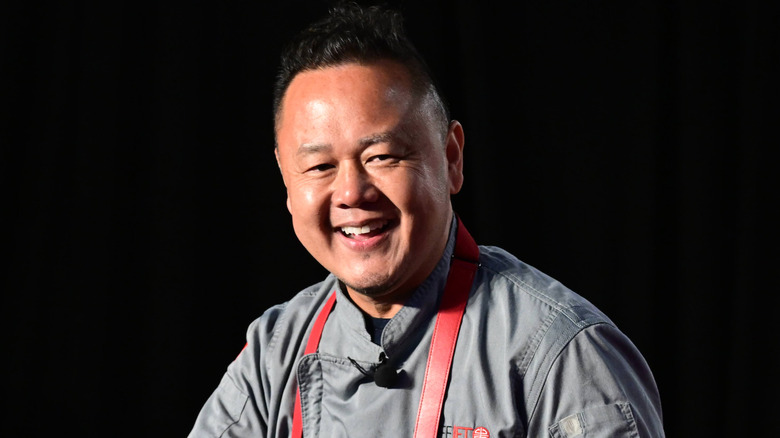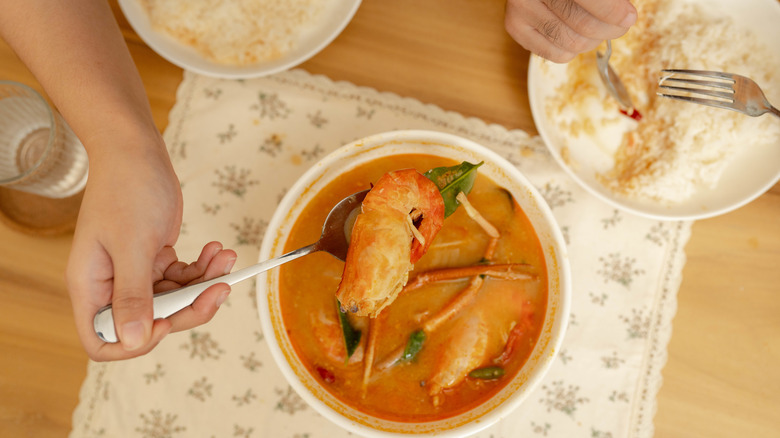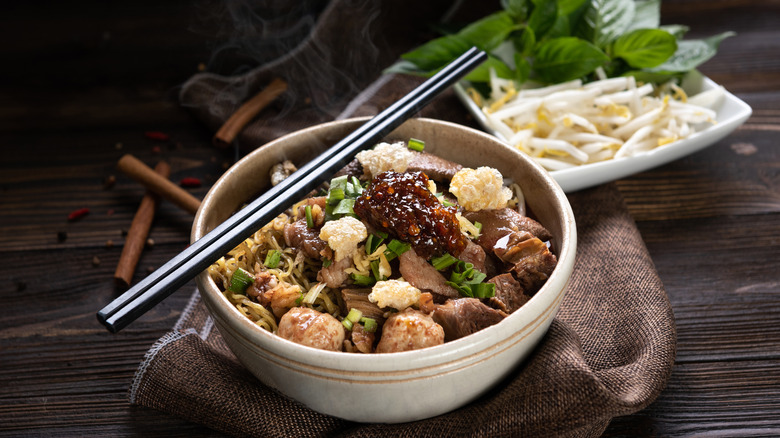Jet Tila's Top Red Flag For Second-Rate Thai Restaurants
Thanks to his family's Thai background, Los Angeles chef Jet Tila knows what makes for good (and not-so-good) Thai food. And he has a useful tip for spotting a promising Thai restaurant that won't even require you to sit down and try the food: Check out the table settings. In an interview with Business Insider, Tila said to look for Thai restaurants that set their tables with a fork and a spoon. He describes this as the "proper" way to eat Thai food, particularly dishes that feature rice. If you're knowledgeable about Thai food, Tila also suggests looking at the menu for specialty regional Thai dishes beyond your standard pad thais and red curries, as this is a hint that the restaurant knows what it's doing (although it may not be a guarantee).
But back to the fork and spoon: If you assumed that Thai food is generally eaten with chopsticks, then you're wrong — and this isn't just Tila's opinion, as plenty of other culinary sources back this up. If a Thai restaurant is putting chopsticks on the table, Tila believes they may be "pandering" to Americanized conceptions of Thai food. They might be leaning into a misconception that all East and Southeast Asian cuisines are eaten with chopsticks. Interestingly, the same applies to countries next to Thailand: Cambodia, for example, also leans towards using forks and spoons; and while the people of neighboring Malaysia use chopsticks sometimes, it's a complicated topic due to the cultural mix of the country.
Why chopsticks aren't used in Thailand
If you visit Thailand (or an acclaimed Thai restaurant) and ask for chopsticks, there's a good chance you might just prompt confusion. There isn't really one simple answer as to why Thai people don't use chopsticks much, but the general theory is that the eating utensil was introduced centuries ago by the Chinese, and it just didn't catch on.
But interestingly, forks and spoons may have arrived later, possibly in the 19th century, when Thai royalty traveled and reportedly brought them back to their homeland. Prior to this, Thai food was predominantly eaten with the hands, but a Thai king at the time found the Western cutlery classier and pressed for the widespread adoption of forks and spoons. However, they're used slightly differently: Thai people tend to use the fork to push food into the spoon and then eat from the spoon. (Knives never really caught on as cutlery, since they were seen as weapons, and weren't so useful since Thai food tends to be bite-sized.)
There may also be a practical reason for avoiding chopsticks in Thai food. Thai rice does not stick together as much as the variations of rice used in East Asia, so it's more difficult to pick up with chopsticks. Spoons just work better in this context.
But there's an exception to the chopsticks rule
Jet Tila does note one exception when it comes to eating Thai food with a spoon and fork, and that's if you're eating noodles. In a noodle house, he says that chopsticks will be the norm. It can vary based on what you're ordering, though. Fried noodle dishes that are served on a plate, like restaurant-quality pad Thai or pad see ew, may still be eaten with either a fork or chopsticks. There's not really a consensus here — some restaurants will provide forks, others will opt for chopsticks for these dishes. Meanwhile, soup-based noodle dishes (served in a bowl) will almost always be eaten with chopsticks. This will include dishes like guay tiew ruea (sometimes called "boat noodles").
The reason why chopsticks are reserved for noodles is generally because noodles were brought to Thailand by Chinese immigrants. Some Thai food guides tend to specifically state that chopsticks are used in Thailand for Chinese-style noodle dishes, as opposed to Thai-style ones like pad see ew. In any case, if you're going out for Thai noodles, chopsticks aren't a red flag for Tila — but if you're looking for the best Thai food, you should probably find a restaurant that prioritizes forks and spoons.


